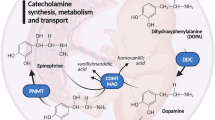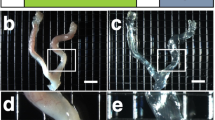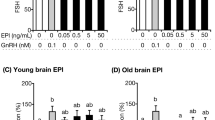Abstract
THE response of the uterus to catecholamines shows considerable variability from species to species as well as within the same species1,2. Thus, norepinephrine has been reported to relax the uterus of non-pregnant rats and to contract the uterus of the gravid rat2. The mechanism of these variations has not yet been elucidated. Recently it has been reported that rat uterus shows cyclic variation in epinephrine concentration3 and in uptake of tritiated epinephrine4. In contrast to heart, brain and other tissues, most of the epinephrine and norepinephrine in the rat uterus was found in the soluble fraction5 (70 per cent). It seemed of interest, therefore, to compare the subcellular distribution of endogenous CA in uteri of various species in order to evaluate the possible relationship of this distribution to the variation in uterine responses to catecholamines.
This is a preview of subscription content, access via your institution
Access options
Subscribe to this journal
Receive 51 print issues and online access
$199.00 per year
only $3.90 per issue
Buy this article
- Purchase on Springer Link
- Instant access to full article PDF
Prices may be subject to local taxes which are calculated during checkout
Similar content being viewed by others
References
Levy, B., and Ahlquist, R. P., in Drill's Pharmacology in Medicine, third ed. (edit. by DiPalma, J. R.), 474 (McGraw-Hill, New York, 1965).
Greeff, K., and Holtz, P., Arch. Int. Pharmacodyn., 88, 228 (1951).
Rudzik, A. D., and Miller, J. W., J. Pharmacol. Exp. Therap., 138, 88 (1962).
Wurtman, R. J., Chu, E. E., and Axelrod, J., Nature, 198, 547 (1963).
Wurtman, R. J., Axelrod, J., and Potter, L. T., J. Pharmacol. Exp. Therap., 144, 150 (1964).
Kahane, Z., and Vestergaard, P., J. Lab. Clin. Med., 65, 848 (1965).
Oskarsson, V., Acta. Endocrinol., 34, 38 (1960).
Miller, M. D., and Marshall, J. M., Amer. J. Physiol., 209, 859 (1965).
Musacchio, J. M., Kopin, I. J., and Weise, V. K., J. Pharmacol. Exp. Therap., 148, 22 (1965).
Campos, H. A., Stitzel, R. E., and Shideman, F. E., J. Pharmacol. Exp., Therap., 141, 290 (1963).
Neff, N. H., Tozer, T. N., Hammer, W., and Brodie, B. B., Life Sciences, 4, 1869 (1965).
Brown, L., Proc. Roy. Soc., B, 162, 1 (1965).
Thoenen, A., Hurlimann, A., and Haefeby, W., Experientia, 19, 601 (1963).
Weil-Malherbe, H., and Posner, H. S., J. Pharmacol. Exp. Therap., 140, 93 (1963).
Green, R. D., and Miller, J. W., J. Pharmacol. Exp. Therap., 152, 42 (1966).
Farrant, J., Brit. J. Pharmacol., 20, 540 (1963).
Author information
Authors and Affiliations
Rights and permissions
About this article
Cite this article
GUTMAN, Y., WEIL-MALHERBE, H. Subcellular Distribution of Norepinephrine in Uteri of Some Species. Nature 214, 108–109 (1967). https://doi.org/10.1038/214108a0
Issue Date:
DOI: https://doi.org/10.1038/214108a0
This article is cited by
-
Adrenergic innervation of the female reproductive tract: Anatomy, physiology and pharmacology
Ergebnisse der Physiologie Reviews of Physiology (1970)
-
Distribution of noradrenaline in the genital organs of the female rat with a remark on dopamine in the cervix and vagina
Experientia (1968)
Comments
By submitting a comment you agree to abide by our Terms and Community Guidelines. If you find something abusive or that does not comply with our terms or guidelines please flag it as inappropriate.



